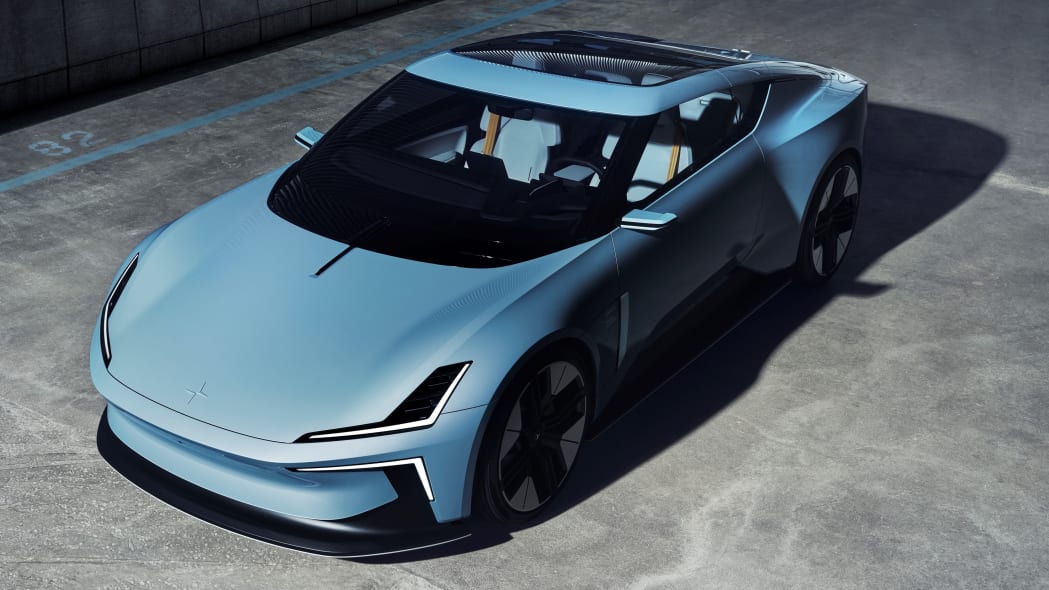Revealed on a 85-degree March day in Beverly Hills, the Polestar O₂ Concept wears a resplendent azure coat just as blue as the cloudless Los Angeles sky itself. The hue is beautiful, but it also signals the concept's intentions — not only that the 2+2's fastback hardtop opens to the heavens, but that Polestar plans to be carbon neutral by 2030.
With the Polestar 1 PHEV sadly departed, Polestar is now a 100% electric brand. And carbon neutrality isn't just a catchphrase. When Polestar talks about its Project Zero initiative, it doesn't fudge the numbers like some automakers do.Play
"It's something that's very dear to my heart," said Maximilian Missoni, Polestar's head of design. "There's no buying offsets, emissions calculations aren't just limited to the use phase of the car."
They're looking at the whole — to borrow a term from Mazda — wheel-to-well lifecycle, from sourcing of raw materials to scrappage.
The O₂ Concept was built with this goal in mind. Take the car's bonded aluminum spaceframe architecture, for example, which was designed by ex-Formula 1 chassis engineers in the cradle of race car engineering, Coventry, England. The body and chassis are together the most carbon-intensive part of the car. So with Polestar, from the outset, the aluminum is melted by renewable energy.Play
The resulting structure isn't just lightweight and stiff, but each type of aluminum used in it is labeled by grade. This allows, when the car reaches the end of its life and is recycled, for different alloys to be separated by purity, which in turn retains the properties of each grade longer, extending the usability and life of that material.
Another example of waste reduction comes in the form of what Polestar calls "mono-materials" used in the cabin. In a traditional car, the interior uses a combination of plastics, leather, wood, metal and other materials the customer never sets eyes on. These disparate materials are fastened together for durability and were never designed for disassembly. When it comes time to recycle them, it's incredibly difficult to separate them, so either it becomes time and energy-intensive to do so, or the whole shebang is simply shredded and thrown into a landfill.Play
Polestar, on the other hand, has developed a single type of thermoplastic that's used throughout the interior. Made from recycled polyester, it serves as the foam, adhesive, 3D knit fibers and non-woven lamination of the O₂'s cockpit. When it comes time to recycle its insides, there's no need to disassemble these components.
"Ironically, we're shifting away from natural materials that need to be retrieved via extensive processes," Missoni said.
"Carbon neutrality is a huge, very tricky thing to accomplish," Missoni said, "but we are moving closer thanks to some of the learnings from the O₂." The concept has not been green-lit, so for now it remains something of a north star for Polestar now that the 1 is gone. The company's CEO, Thomas Ingenlath, calls it "the hero car for our brand.”
Part of its purpose is to show just how varied the company's platform can be. The same architecture that underpins this open-top 2+2 also underpins the Precept concept, a large GT that will come to market as the Polestar 5 a couple of years from now. It follows with some design cues as well, like the separated "Thor's hammer" headlights, functional ducts for airflow over the wheels, and taillights that function as air blades to pull drag-generating turbulence from the rear of the car.
As a fully electric convertible, the O₂ promises to deliver an all-new driving experience as well, in which the car silently glides along with no combustion noise when the top is down. While there may be no engine drone, there will be an entirely different kind of drone.Play
While driving, the O₂ can release a flying camera drone from its rear deck. A door opens and the drone, magnetized to a stand, rises from its compartment. When the magnet releases, the drone follows the car, flying in a selection of pre-programmed routes relative to the vehicle and recording your fabulous Polestar life for jealousy-inducing social media posts. The drone can follow as long as the car keeps to 56 mph or below, but the car must be stopped for the drone to return to base, or for the video to be edited or shared from the car's 15-inch center display.
While we suspect that the drone party trick will catch a lot of ink, we didn't lead with it. That's because we think the real nut meat of the O₂ Concept is the way in which it inches the company towards its sustainability goals. Many automakers talk about it, but few are taking a holistic approach. The O₂ might not see production any time soon — Polestar already has an ambitious lineup of models slated for the next three years — but the philosophy behind it can't come soon enough.



0 Commentaires